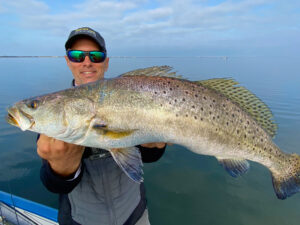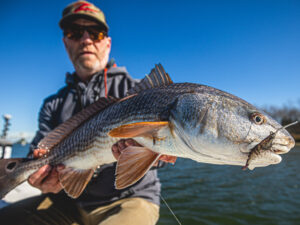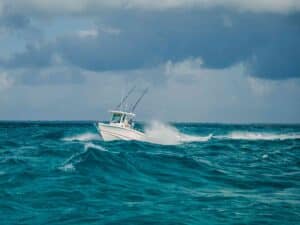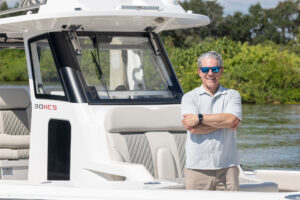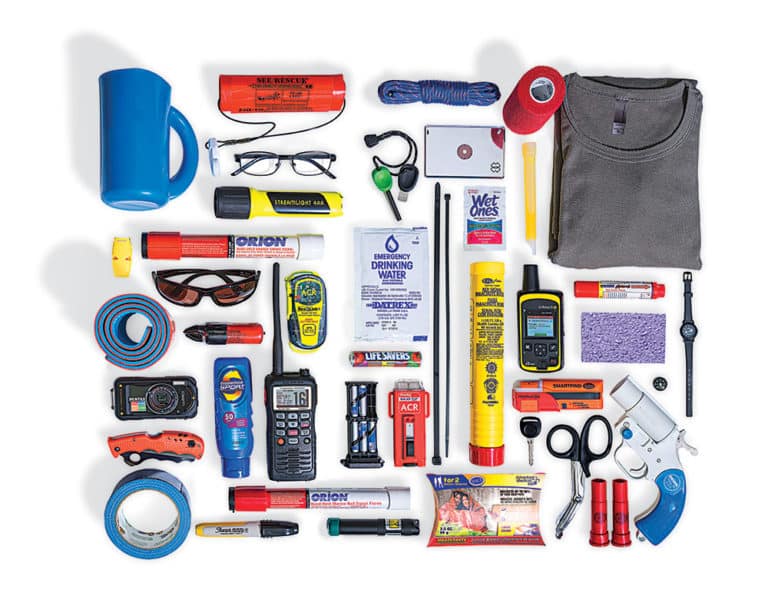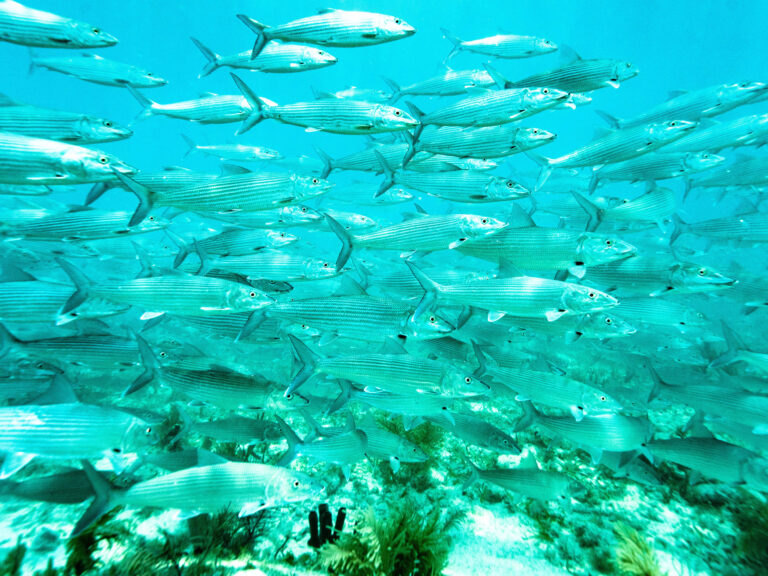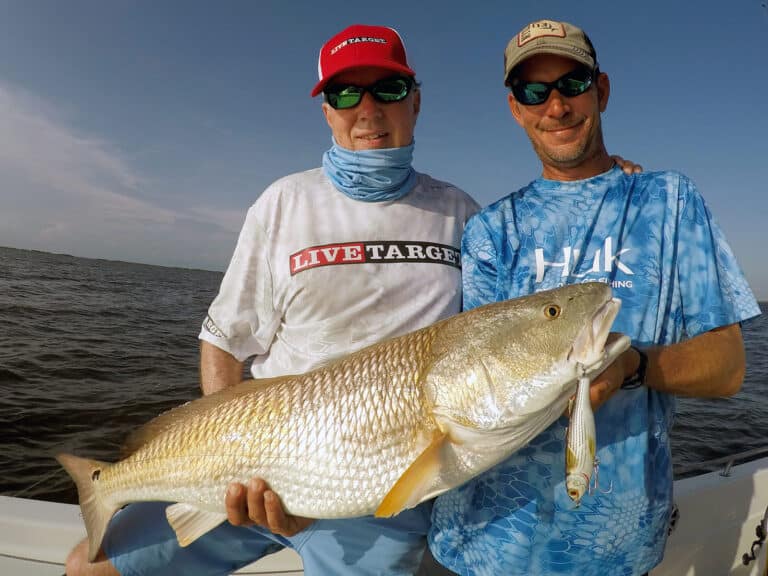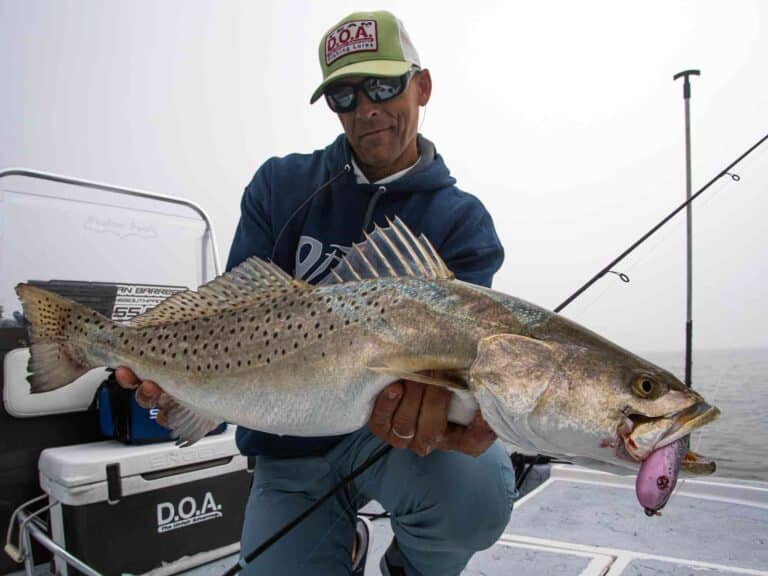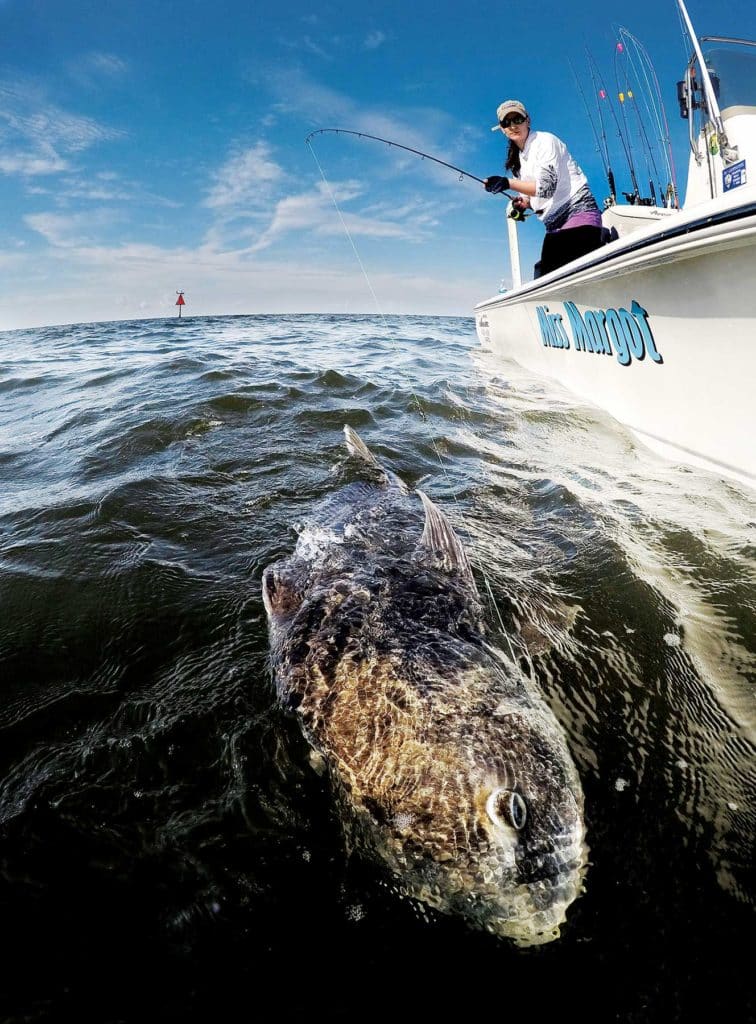
“You’ve gotta try fishing our inshore reefs!” Capt. Sonny Schindler had told me, months before I traveled to the Mississippi coast to do just that. “They’ve really been complete game-changers for inshore-fishing guides in this area,” added Schindler, based in Bay St. Louis, Mississippi, just west of Gulfport.
And that’s how I came to be on Schindler’s Avenger AV26 bay boat, anchored in about 8 feet of water in the Gulf of Mississippi just around the corner from Bay St. Louis, on a breezy August morning.
As I worked a white 3½-inch Z-man ElaZtech GrubZ tail on a quarter-ounce lead-head back toward the boat, out of the corner of my eye, I noted the line of the angler to my left begin to tighten when something picked up her shrimp.
That angler happened to be my daughter, Rachel. I have grown used to her catching the first (and most) fish, so the strike came as no surprise. But I was surprised by the power of whatever now had Rachel’s spinning rod bucking, the fish heading toward the rubble of what was once the Interstate 10 bridge that had spanned the nearby Jourdan River. This was no small fish.

Mississippi Inshore Reef Facts
• Most sit in 4 to 10 feet of water, just a mile or two off the beach.
• The reefs are made up of crushed concrete, limestone and oyster shells.
• Signs mark the location of the reefs.
• Download a complete map with GPS coordinates at dmr.ms.gov (see “Artificial Reef” under the “Marine Fisheries” tab). Sport Fishing
Light-Line Challenge
Clamping down on the spool, Rachel risked snapping the light braid but knew if she didn’t stop her prize quickly, the rubble would claim it. She managed to turn the fish’s head, and then gradually worked it to the boat, its runs short but powerful.
Shortly after that, Schindler was sliding a landing net beneath the head of a black drum that would have gone 30 pounds or so, which we released after some quick photos.
Schindler says it’s not unusual for big blacks to move in and set up shop on the I-10 structure. When they do, and while the tide is right, the action can be nonstop.
Our experience suggested that was no exaggeration. Just after we released Rachel’s fish, I set down my camera and picked up my little Shimano Stradic filled with 15-pound braid. On the second cast, my light Hanta rod bent double as another large black inhaled the GrubZ tail. Black drum can seem rather sluggish compared with reds, but fish of that size on such light tackle prove an exciting, often touch-and-go challenge.

Tons of Concrete
Mississippi’s inshore-reef-building program started just after the turn of this century, says Schindler. “Our former congressman, Gene Taylor — who’s an avid fisherman — got it all started. When that I-10 Jourdan River Bridge needed to be replaced, he had the tons and tons of concrete placed just offshore of Bay St. Louis,” Schindler says, noting this would later be named Taylor Reef (or, as it appears on state reef maps, Square Handkerchief Key).
The reef program, overseen by the Mississippi Department of Marine Resources, got a boost after “Hurricane Katrina provided plenty of reef-building material,” as Schindler puts it, “that would later create dozens and dozens of fish-attracting reefs near the shore.”
Dozens indeed. The state’s current number of DMR inshore reefs totals 73, stretching from Louisiana nearly to Alabama.
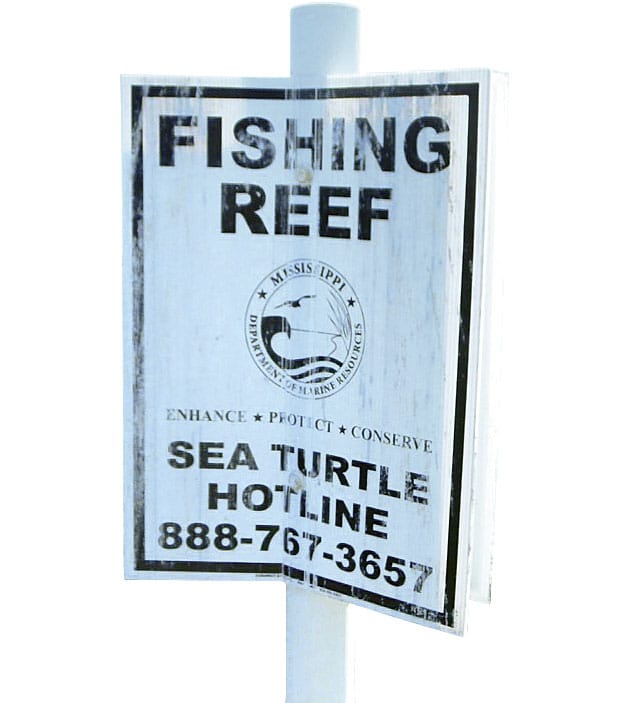
Schindler explains why these reefs are so critical to the state’s excellent inshore fishing. Prior to so many reefs, waters just off the state’s beaches were shallow and barren, with little to attract or hold fish.
“Our guides [and local private-boat anglers] depended heavily on fishing Louisiana marshes, 9 to 12 miles south of Hancock County,” the state’s westernmost county, bordering Louisiana. “The open-water crossing to the Louisiana marsh can be very difficult, particularly in windy winter weather,” Schindler says.
“But once these reefs began growing barnacles and oysters, and attracting baitfish, it was game on!”

Multiple Species in Easy Reach
While big, bearded black drum demanded a starring role on the days we fished some of these reefs, we brought other species to the boat, including tripletail, which Schindler tagged and released. Mississippi’s coastal waters, at times, offer Schindler and fellow guides a world-class fishery for tripletail, with some days producing multiple 20-plus-pound fish.
Of course, we also caught sheepshead and spotted seatrout. Trout move onto the reefs in the greatest number, along with redfish — including, at times, some big bulls for such shallow water — in spring and summer, says Schindler, who has caught trout to 6 pounds off Taylor Reef. Besides soft plastic baits and topwaters, Schindler likes to have some large bull minnows in his well, for trout, tripletail, reds and flounder.
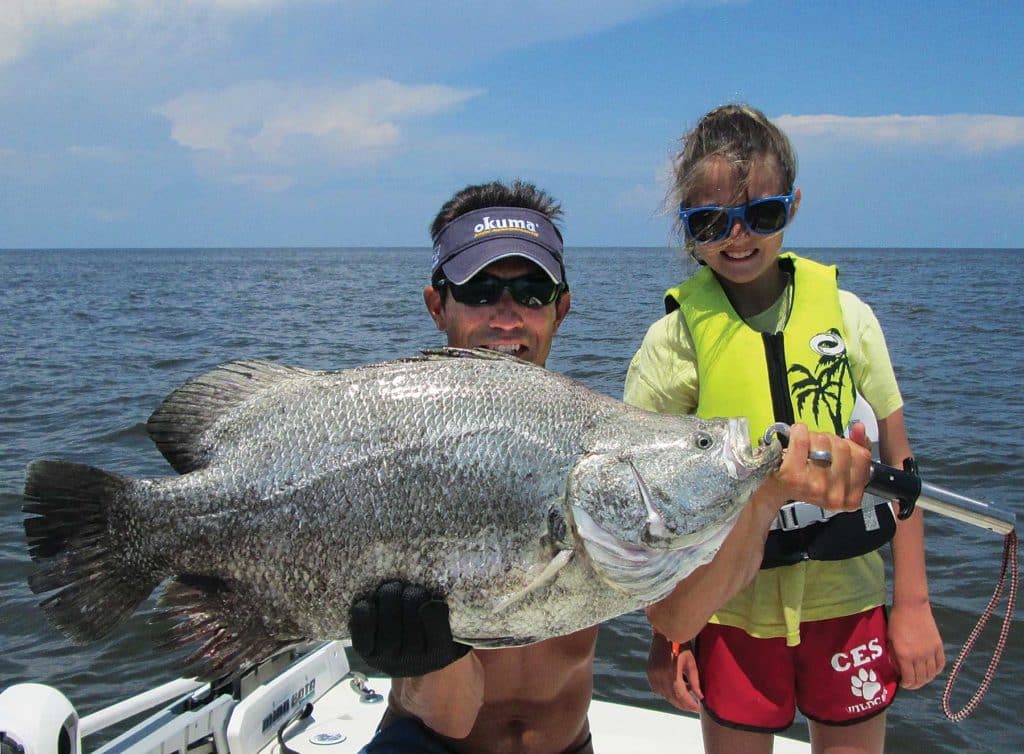
The reefs provide year-round action, and in fact, Schindler says, the cooler months of winter can be a great time for fun fishing, when sheepshead, slot redfish and black puppy drum gang up, and anglers are delighted at both the pace of action and coolers full of fish for the freezer.
Not only have these reefs meant great year-round sport, Schindler says, but with so many reefs so close to shore, anglers can take advantage of more or less immediate access to start catching fish. Not having to make a long, open-water run to start fishing meant that Schindler’s Shore Thing Charters could offer half-day trips at quite reasonable rates, the guide says, adding, “Our Mississippi nearshore four-hour trips have become one of our most popular options.”
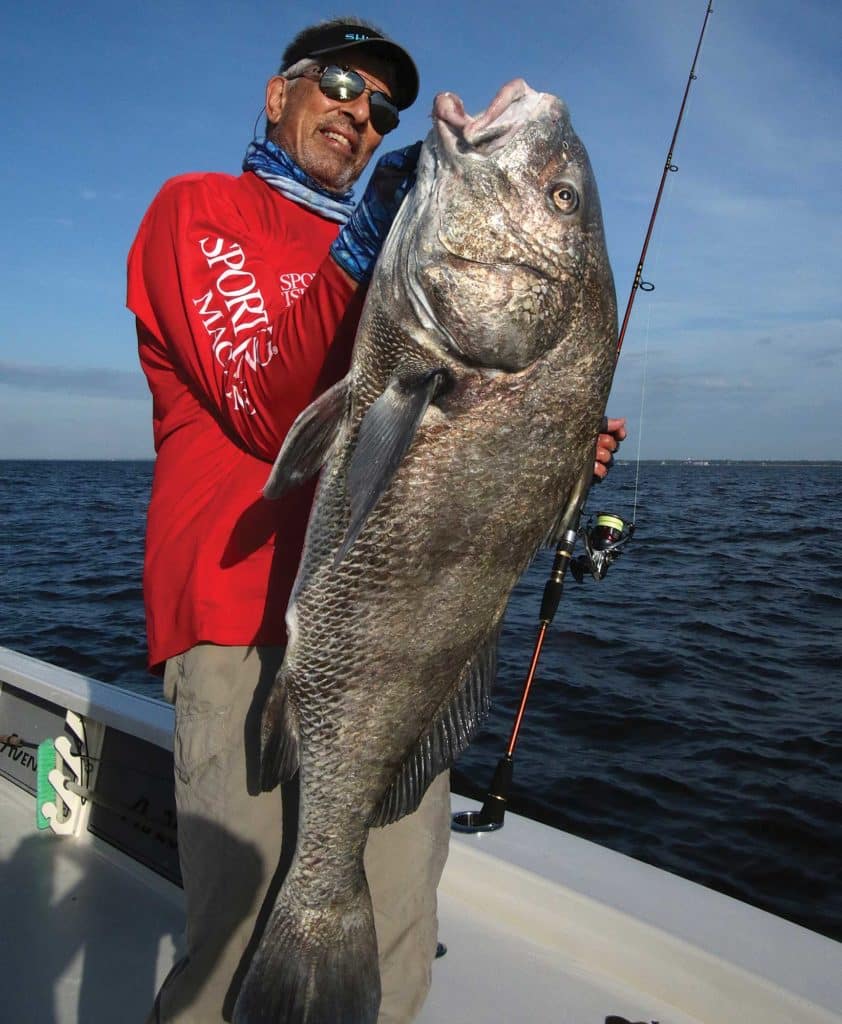
Saucer Eyes
Thinking about my experience on these reefs with Schindler, I pictured the shape of big black drum materializing in the silty water next to the boat, eased in on light tackle, and how cool that was.
So I wasn’t particularly surprised to hear Schindler say: “Those big blacks are what most of our inshore anglers want to tangle with. Being able to catch monsters up to 50 pounds on light tackle has become the highlight of many trips. I can’t begin to tell you how many times we hear, ‘That’s the biggest fish I’ve ever caught!’ It’s especially rewarding to hear that from young kids, as well as older anglers who have been fishing inshore for decades.”

That mention of “young kids” particularly resonated with me, recalling the morning I went along on a family outing with my son, Gabe, and his wife, Autumn, and their two young sons, Quinn and Dashel. The boys had little fishing experience; helping to reel in a fish quite literally as large as or larger than each of them made for a morning neither will forget (as evidenced by their saucer-size eyes when Schindler pulled these fish into the boat for a pre-release photo).
The kids also had the chance to see other species, including some small tripletail. I could see how a four-hour trip could be ideal for such a family: not so long that youngsters lose interest but offering pretty close to guaranteed action throughout the morning or afternoon.
Whether anglers are young or old, novices or veterans, the bountiful inshore reefs of Mississippi mean abundant action awaits right around the corner.

Species Availability: Mississippi Inshore Reefs
Planning a Trip to Fish Mississippi’s Inshore Coast
Thanks to its inshore reefs, fishing just off the state’s beaches can be productive along the length of the coast, and at any time of the year.
Summer is hot but generally calm. Afternoon and evening thunderstorms are the norm, with the threat of tropical weather increasing as summer progresses. Winter months can be ideal between fronts, if a bit chilly. (High-pressure winds from the north might be brisk but also blow offshore, making for flat water off the beaches.)
Multiple Fishing Opportunities
Fishing the Louisiana marsh is a very different experience from that offered over artificial reefs, requiring a bit more commitment in time and expense, but worthwhile when world-class action for big bull reds in the shallow water is on. On the outside, nearshore coastal pelagics such as cobia and king mackerel can be abundant, and beyond that, over deeper reefs, wrecks and (even farther) oil-rig structure, anglers find plenty of red snapper, grouper, amberjack and more.
Read Next: Fishing the Chandeleur Islands
Visiting Biloxi-Gulfport
The Mississippi Coast has two faces: its casinos and its family-friendly Gulf beaches and water activities. These are by no means mutually exclusive. On our visit, we focused primarily on family activities because there’s much for kids to enjoy here.
The tourist-oriented area boasts no shortage of hotels, but larger groups might find a better option to rent a house, as we did. Good eateries abound. Darwell’s Cafe in Long Beach, a favorite of ours, cooked up consistently outstanding New Orleans-good Cajun dishes. Of course, anglers renting a house can also cook up fresh fish from a day’s catch — or, alternatively, they can take their fish to Blind Tiger Restaurant in downtown Bay St. Louis: For Shore Thing Charters anglers (only), the restaurant will cook ’em up for you.
Contacts
Fishing: Shore Thing Charters — Seven captains (including Schindler) fish from seven (23- to 26-foot) bay boats up and down the coast and in the marsh. Contact them at shorethingcharters.com.
Accommodations: We used Vacation Rentals by PRM (vacationinbiloxi.com) to find a great house with several bedrooms. Particularly for large groups, this is a great way to go.
General information: Visit gulfcoast.org. For state fishing regulations, visit dmr.ms.gov and see “Recreational Catch Limits” under the “Recreational Fishing” tab.

